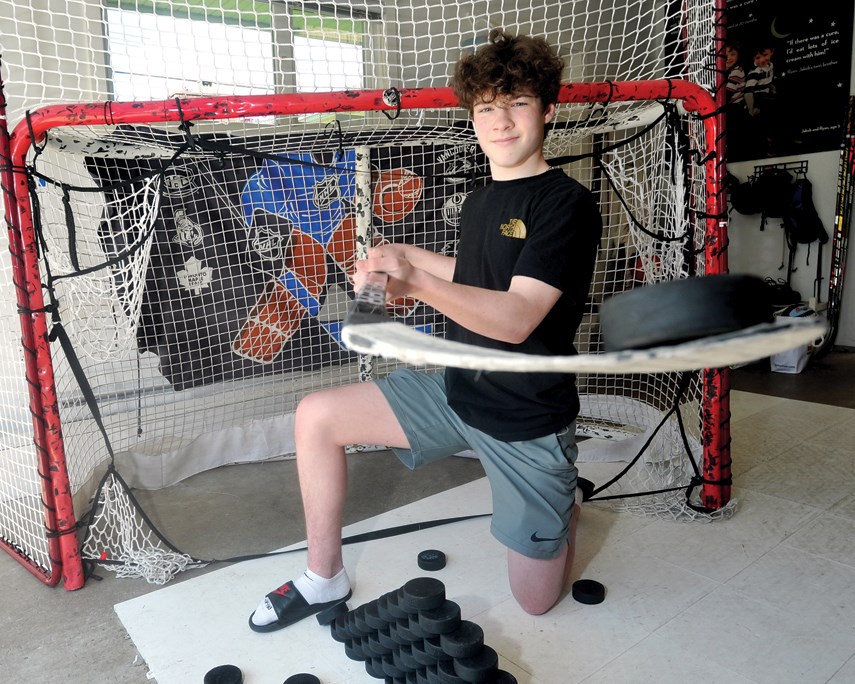In the summer of 1921, Frederick Banting and Charles Best of the University of Toronto started giving a “pancreatic extract” to patients suffering from diabetes.
The substance was insulin, the results were miraculous, and over the next 100 years it would save and enrich the lives of millions of people around the world.
North Â鶹´«Ã½Ó³»14-year-old Jakob Tice, known as Jake to his friends, is one of those people. Diagnosed with type 1 diabetes at the age of two, he now uses insulin every day to stay alive and to thrive as an active, athletic teenager and high-level hockey player.
“It would feel weird, what it’d be like without insulin,” Jake told the North Shore News. “I don’t know what I’d do without it.”
It’s still, however, nearly a full-time job for Jake and his family to manage his diabetes. He’s got an insulin pump attached to his body, as well as a Dexcom CGM system that monitors his glucose levels and sends updates to his phone. Exercise can cause sugar lows, so during hockey games Jake has to constantly monitor his body and sometimes needs to sit out if his levels are low.
The consequences of neglecting his diabetes management would be dire, says his mom, Michelle Tice.
“You can end up going unconscious from a sugar low and then eventually, if you don't deal with it, you can die,” she says. “We take care of it so it doesn't happen.”
And so as people living with diabetes celebrate the 100-year anniversary of the insulin breakthrough, they are also looking forward to the potential of another breakthrough that won’t just manage diabetes, but beat it. They’re looking for a cure.
“I think it’s for sure going to happen,” says Jake, adding that a cure would be life-changing for him. “It’d mean so much. When COVID is not around I’d be able to go have sleepovers with my friends. During games I wouldn’t have to get off the ice to check my blood, and if I’m low I wouldn’t need to sit. It’d mean a lot. I wouldn't need to be worrying so much. If I have a headache I’d just be like, ‘oh, I have a headache,’ instead of being like, ‘Oh, am I low? Am I going low?’ I wouldn’t need to worry in the middle of the night about having a blood sugar low or high.”
In an effort to speed up that chase for a cure, Jake has taken on a 100 Challenge in conjunction with the annual Sun Life Walk to Cure Diabetes for JDRF. He’s been the inspiration for the which has taken part in the annual Walk to Cure Diabetes for the past 13 years, raising more than $50,000 combined over the years.
This year Jake will be adding his own challenge to the fundraising effort. He’s pledged to shoot 100 pucks a day for 16 straight days, making use of the hockey net setup he has in his garage. Why 16? It’s a nod to two of his idols, hockey players Bobby Clarke and Max Domi.
Both players wore the number 16 in the NHL, and both reached great heights in the sport despite having type 1 diabetes.
“They do everything that I do and they have a chance, so that means I have a chance of making it to the NHL,” said Jake. “I look up to them. If they made it, I can make it.”
So far the Jumping for Jakob fundraiser for this year has raised nearly $6,000, blowing away his initial goal of $500. As of Friday, May 21, Jumping For Jakob was in . The campaign ends Sunday, June 13 at 10 a.m. Pacific time.
Jake's hope now is to push past $10,000. Whatever amount his fundraising campaign ends up at, he said it means a lot to him that people are helping him and everyone else living with diabetes as they search for a cure.
“It means that people are there to support me,” he said. “They care about me and they want me to live without diabetes.”
Visit the to donate to his team.

